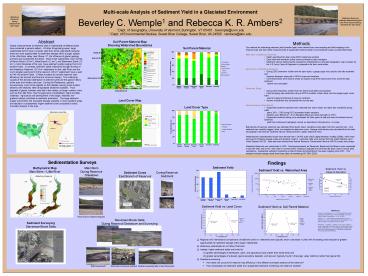Multiscale Analysis of Sediment Yield in a Glaciated Environment - PowerPoint PPT Presentation
Title:
Multiscale Analysis of Sediment Yield in a Glaciated Environment
Description:
Watershed and subwatershed areas were derived from 1:24,000 scale USGS digital ... U.S.: Assessing baseline conditions and effects of ski area development. ... – PowerPoint PPT presentation
Number of Views:68
Avg rating:3.0/5.0
Title: Multiscale Analysis of Sediment Yield in a Glaciated Environment
1
Multi-scale Analysis of Sediment Yield in a
Glaciated Environment Beverley C. Wemple1 and
Rebecca K. R. Ambers2 1 Dept. of Geography,
University of Vermont, Burlington, VT 05401.
bwemple_at_uvm.edu 2 Dept. of Environmental
Studies, Sweet Briar College, Sweet Briar, VA
24595. rambers_at_sbc.edu
Waterbury Reservoir during drawdown for dam repair
Waterbury Reservoir sediment deposits along the
Little River exposed during drawdown for dam
repair
Abstract Global measurements of sediment yield in
watersheds of different sizes have produced a
general pattern. All other things being equal,
large watersheds tend to have a smaller yield
than small watersheds because there are more
opportunities for sediment storage within a
larger system. In the Little River valley near
Stowe, VT, the influence of glacial geology and
land use counteracts this trend. Some small
watersheds, such as that of Ranch Brook (10 km2),
West Branch (12 km2), and Stevenson Brook (15
km2), minor tributaries of the river, have
sediment yields ranging from 6-23 tons/km2/year.
In contrast, sediment yields measured through
surveys of the Waterbury Reservoir (281 km2
watershed) on the Little River and the much
smaller east branch of the reservoir (20 km2
watershed) have a yield of 146-188 tons/km2/year.
(These numbers do not take reservoir trap
efficiency into account and thus are minimum
values.) The underlying causes of this bimodal
distribution in sediment yield are the glacial
history of the area and modern land use. During
the Pleistocene, glaciers scoured away much of
the regolith on the hillsides, leaving small
modern streams with relatively little
transportable sediment available. Thick deposits
of glacial outwash were left in the valleys, so
larger modern rivers such as the Little River,
flow through poorly consolidated, highly erodible
materials. Agriculture and development in the
larger, relatively low-gradient valleys
contribute to sediment production. The large
sediment supply overwhelms the increased storage
available in lower gradient areas and results in
a substantially higher sediment yield compared to
small, mountain streams in the area.
Soil Parent Material Map Showing Watershed
Boundaries
- Methods
- Our methods for estimating sediment yield
(tons/km2/year) were derived from core sampling
and field mapping in the reservoir area and from
direct measurements of suspended sediment yield
in two headwater basins as described below. - Main stem of Waterbury Reservoir
- Depth sounding from boat using GPS to
determine location - Exact lake level elevation during survey
provided by dam managers - Sediment volume determined by comparison of
bathymetry to pre-lake topographic map surveyed
by - the U.S. Army Corps of Engineers in
preparation for dam construction - East branch of Waterbury Reservoir
- During 2002 drawdown of lake level for dam
repair, a gouge auger was used to core lake
sediment and - measure thickness along with a GPS to map
core locations - Core thicknesses were used to create an
isopach map of the east branch from which the
total sediment - volume was calculated
- Stevenson Brook
- During 2002 drawdown of lake level, the entire
brook delta was exposed - Field surveying was performed using a GPS for
location stream bank cuts and gouge auger cores
were - used to measure thickness of reservoir
sediment
Land Cover Map
Sedimentation Surveys
Findings
Coring Reservoir Sediment
References Dendy, F. E. and Bolton, G. G., 1976.
Sediment yield-runoff- drainage area
relationships in the United States. Journal of
Soil and Water Conservation, v. 31, p.
264-266. Walling, D. E., 1994. Measuring sediment
yield from river basins. In R. Lal, ed., Soil
Erosion Research Methods, 2nd ed., Soil and Water
Conservation Society, p. 38-80. Wemple, B., J.
Shanley, J. Denner, D. Ross, and K. Mills, in
review. Hydrology and Water Quality in Two
Mountain Basins of the Northeastern U.S.
Assessing baseline conditions and effects of ski
area development. Submitted to Hydrological
Processes (Scientific Briefings).
- Regional and international comparisons of
sediment yield vs. watershed area typically show
a decrease in yield with increasing area because
of greater opportunities for sediment storage
within larger watersheds. - Waterbury watersheds do not follow this trend.
- Instead, higher sediment yields are linked to
- greater percentages of developed, open, and
agricultural land (rather than forest land) and - greater percentages of outwash, glacio-lacustrine
deposits, and alluvium typically found in the
larger valley bottoms (rather than glacial till). - Questions remaining
- How does one account for reservoir trap
efficiency in the different surveyed sections of
the reservoir? - How comparable are sediment yields from suspended
sediment monitoring and reservoir studies?

